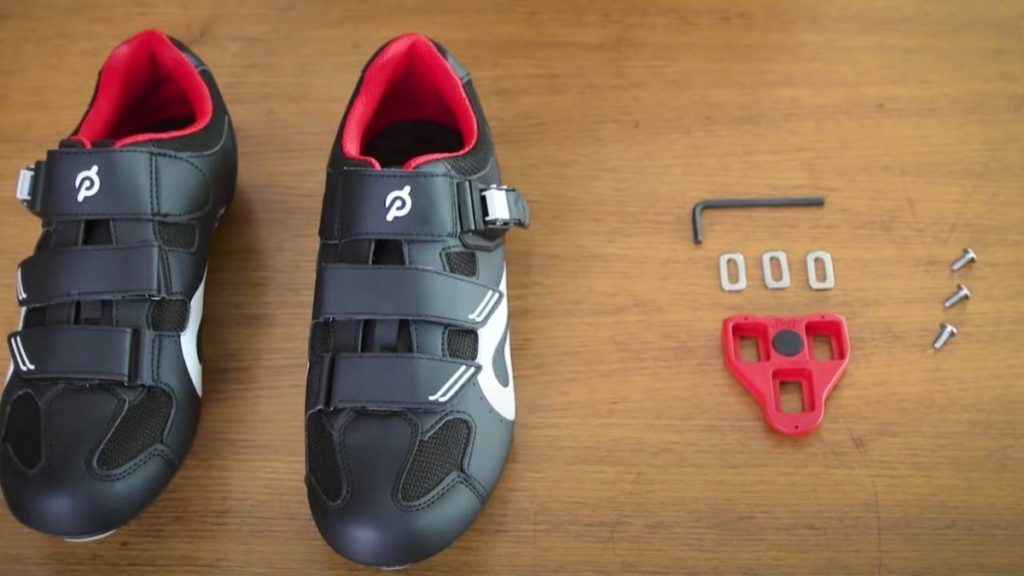
As a avid Peloton rider you might want to know why do my peloton shoes squeak? Is it normal for peloton shoes to squeak or is it actually your peloton pedal squeaking and not your Peloton shoes?
In general, any pressure on your Peloton shoe will make noise because our foot shapes are all slightly different, and the shoes alter your foot pressure on the pedals. Furthermore, your cleats, Peloton pedals, and bearings can make your Peloton shoes squeak if they haven’t been lubricated and maintained.
Table of Contents
Why Do My Peloton Shoes Squeak
For months, I’ve been cycling my Peloton bike and quickly noticed a strange squeaking noise coming from my Peloton shoes and Peloton pedals, especially my left foot. When I stand up and go hard during my class, I find the squeak gets worse and louder.
So, what causes the squeaking noise on a peloton shoe? And more importantly, how do you fix it without buying expensive cycling shoes?
Basically, your feet are not shaped the same all the way around. If you put pressure on one part of your foot, it makes an imprint on the shoe that alters its shape slightly. The same thing happens with your Peloton shoes, and since they are so thin and tight, any sort of pressure on your foot will create a squeaking noise.
However, I decided to buy a different pair of cycling shoes instead of the Peloton shoes and found it did the same thing. Every time I stood up to do a hill climb, I discovered my left foot would always squeak regardless of the type of cycling shoe I had.
Then my wife put on her Peloton shoes, and guess what? It did the same thing. Her feet would also squeak at the exact same point in the class and on the same left side as mine. So, I investigated and discovered it wasn’t just my Peloton shoe causing the squeak. It was the cleats and pedals, so here’s how I solved the problem of the why my Peloton shoes squeak.
Recommended Products to Stop Squeaking
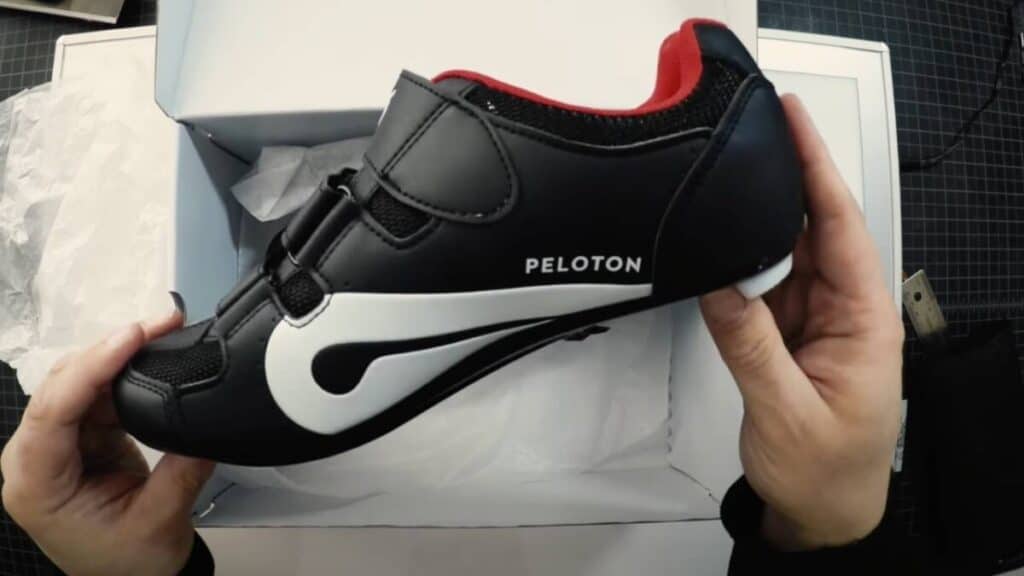
5 Common Reason Peloton Shoes Squeak
1. Peloton Shoes are the Wrong Size
If your shoes are too big or too small, they’re going to squeak. Your foot will move around inside your shoes making them squeak because of the extra space. If they are too tight your feet will rub on the inside of the Peloton shoes making a squeaking sound. Make sure you’re wearing the right size shoe by checking the Peloton sizing chart.
2. Your Foot has an Arch
If you have high arches, your shoes are more likely to squeak. This means your foot isn’t flat inside your Peloton shoe. The extra space between your foot arch and your Peloton shoe. Each time you push down on the Peloton pedal you will hear a squeaking noise. You can solve this problem by getting insoles or orthotics for your Peloton shoes.
3. Wrong Socks
Believe it or not, the type of sock you’re wearing can also affect whether or not your shoes squeak. If you’re using cotton socks, they will absorb sweat and moisture, which can cause your shoes to squeak. Instead, try wearing moisture-wicking socks made from synthetic materials. There are socks specifically designed for cycling (Amazon link to my favourite socks).
4. Your Peloton Cleats are Loose
If your cleats are loose, they’ll move around and rub against the Peloton pedal, which will cause them to squeak. Make sure your cleats are tight before each ride. Your Peloton shoes should come with a Allen key which is designed for your cleats. I tighten my Peloton cleats before every ride and it has stopped my Peloton shoes from squeaking.
5. Peloton Shoes not Lubricated
Just like any other piece of machinery, if your Peloton shoes aren’t properly lubricated, they’ll start to squeak. You can buy special cycling shoe lubricant or use Vaseline petroleum jelly. Apply a small amount of lubricant to the area where the cleat meets the Peloton pedal and where the shoe rubs against the pedal.
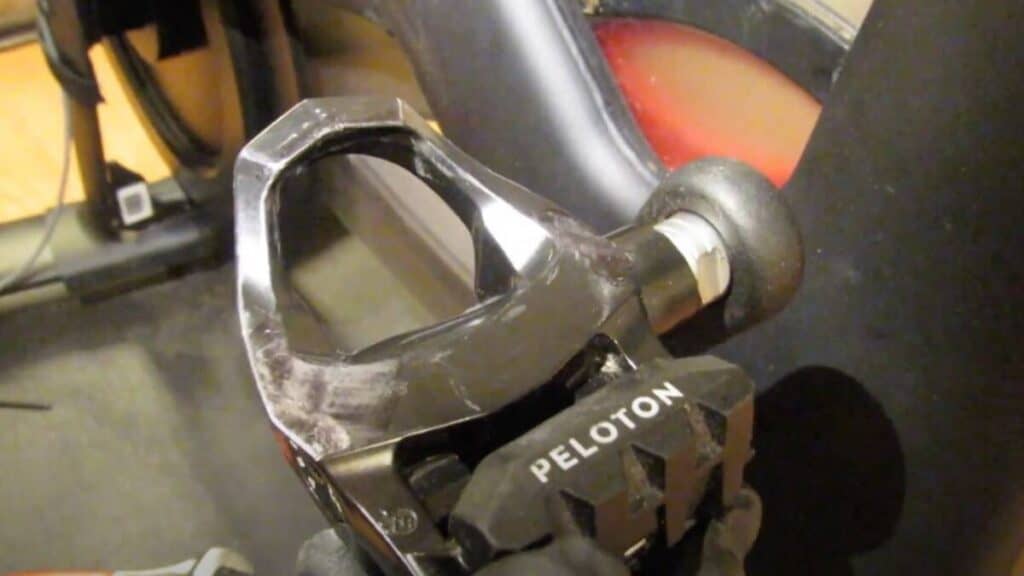
3 Reason Your Peloton Pedals Squeak
1. The Peloton Pedal is Loose at the Crankshaft
If your pedal is loose at the crankshaft, this is most likely the cause of the Peloton pedal squeaking noise. If the crankshaft is loose it means your entire Peloton pedal could come off. To fix this, simply tighten the pedal using a 15mm wrench until its hand tight. If you over tighten the crankshaft it could damage the bearing inside.
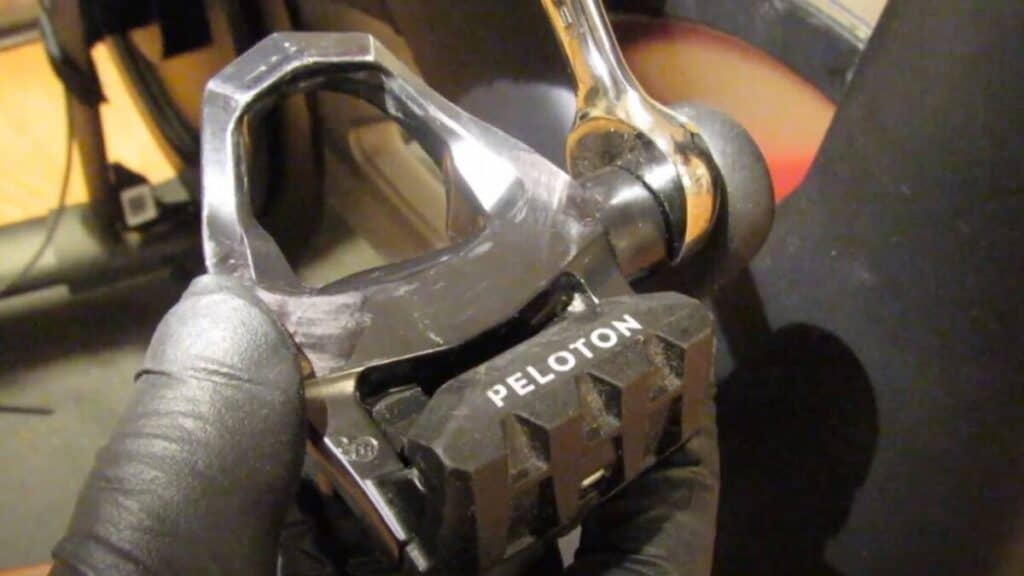
2. The Peloton Pedal is not Lubricated
If your Peloton pedal is not lubricated, this can also cause squeaking. To fix this, simply apply some lubricant to the pedal, and any moving parts around the Peloton pedal. The crankshaft is another place to add a small amount of lubricants.

3. The Clipless Pedal is too Tight for the Cleat
If your clipless pedal is too tight for the cleat, this can also cause squeaking. If you find it difficult to clip your Peloton shoes into the pedals it means the pedal is too tight. To fix this, simply loosen the tension on the pedal using a small 3mm Alley Key or crew driver depending on the design of the Peloton pedal.
How Do I Stop My Peloton Shoes & Pedals From Squeaking
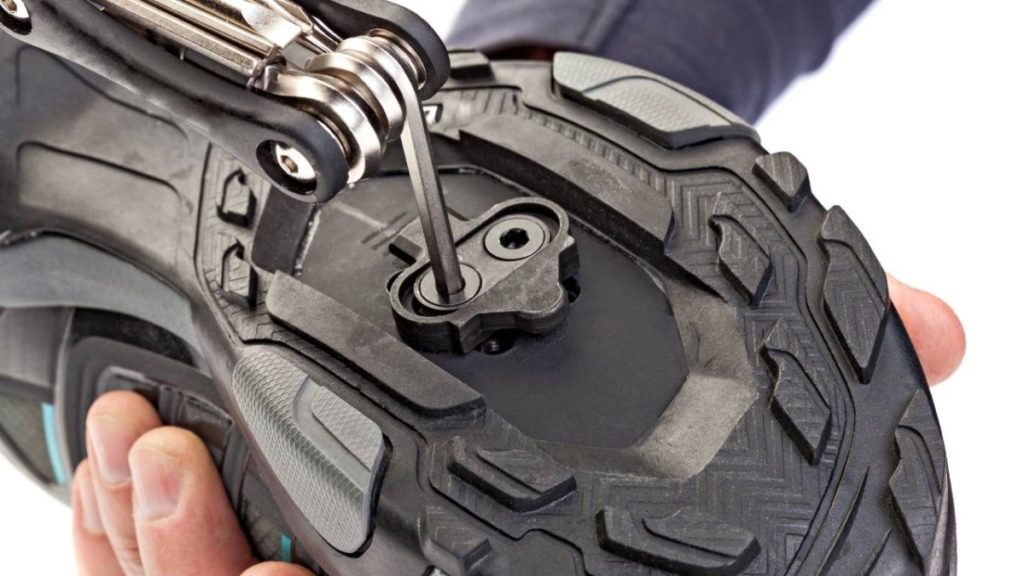
When you first buy a Peloton bike, everything comes brand-new, shiny and out of the box. None of it is pre-lubricated or protected before you commence riding your Peloton bike. This is the main reason for your Peloton bike making squeaking noises. Your shoes and cleats cause too much friction on the pedals, producing noises you weren’t expecting in the first place.
I simply bought a Muc-Off kit which you can find in the link here and applied the lubricant spray and cleaning solutions before and after my cycling ride. It instantly reduced any noise from the cycling bike and eventually stopped the squeaking noise forever. Here’s how I did it.
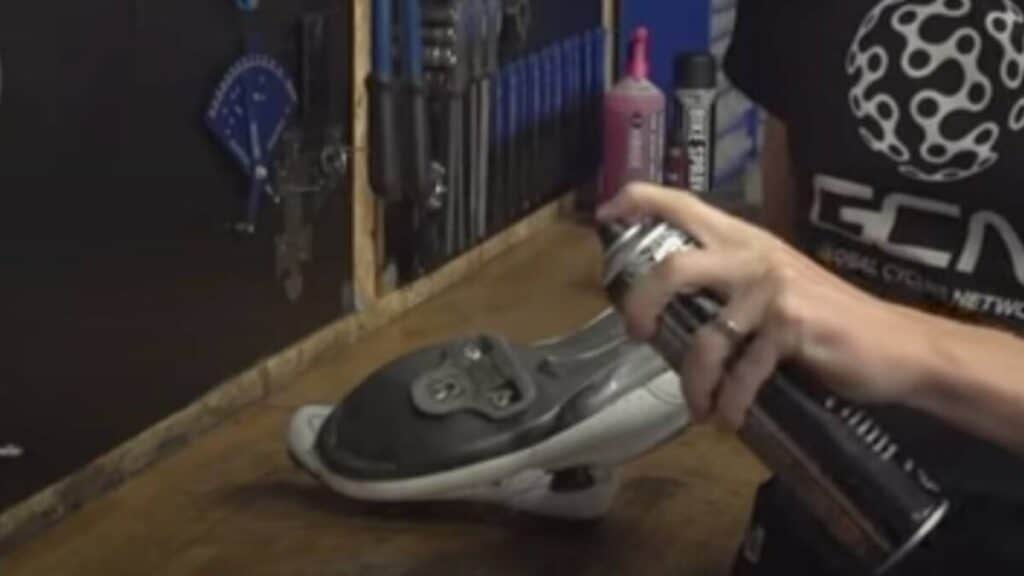
1. Spray The Peloton Cleats
I began with the Muc-off general-purpose spray to spray the top part of my cleats located underneath my Peloton cycling shoe. The friction between your cleats and pedals cause a lot of squeaking noise, particularly when you’re moving from seated to standing positions. The movement and rocking of your foot produce grinding and squeaking sounds between the pedal and cleat.
For an added layer of protection, I also applied a small amount of the dry lube along the top and bottom of the cleats and rubbed it into all the areas, adding an extra barrier of protection from the cleats and the pedals. Furthermore, it assisted me to clip my foot in and out of the pedals, which I struggled with initially.
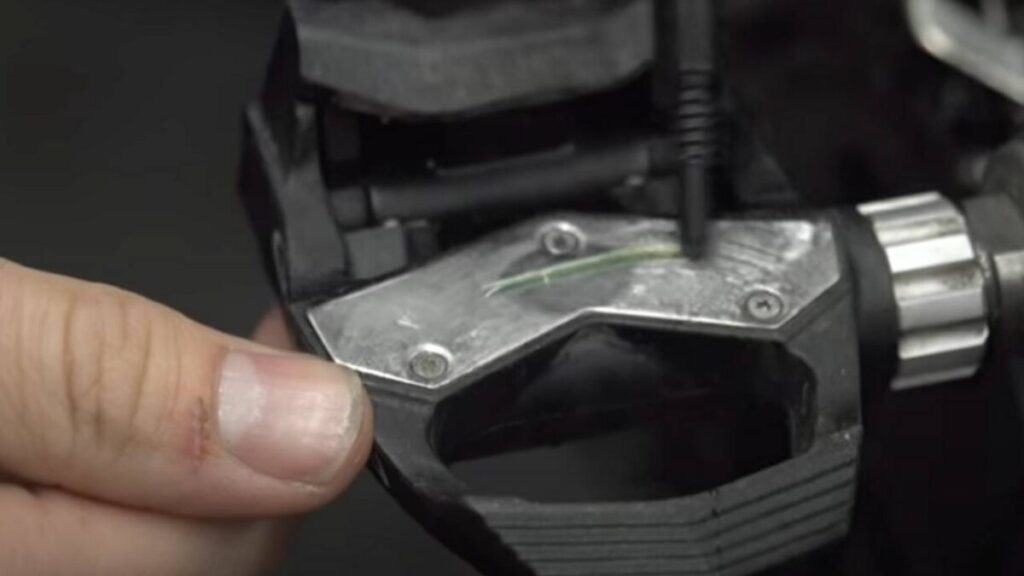
2. Tighten The Cleat Screws
The first thing to check on your cleat is that the screws are completely tightened to your shoe. However, if you decide to check your screws, remove them all and apply a small amount of grease to lubricate the screws and then re-attach your cleats to your Peloton shoe.
If you notice your cleats look worn out and well used, it could be an easy fix to replace them. Here is my recommendation. But when your new cleats arrive, make sure you spray and lubricate them before hopping back on your bike.
3. Lubricate The Peloton Pedals
I applied a small amount of dry lubricant to the area where the cleats attach to the pedal. Additionally, I touched a tiny measure of the dry lubricant to the middle and end of the pedal. Don’t over apply the lubricant because it can make the pedal slippy causing problems when you clip your cleats in before your next ride.
I only apply dry lubricant to my pedals once a week, and I find it’s enough to stop the squeaking, and it helps the clipping in and out process. If you have changed your Peloton pedals for SPD pedals, then make sure you lubricate both sides. For flat pedals, there’s no need to grease the pedal.

4. The Pedal Bearings and Screw
Removing your pedals from the spin bike will give you an opportunity to grease around the screw end of the pedal that connects into the crank of the spin bike. It also lets you double-check that the bike pedal is fully tightened into the crank, which sometimes becomes slackened and creates noise when you are rotating your pedal.
You can also lubricate the bearings of the pedal itself, which again reduces the risk of the bearing failing and causing unnecessary noise. If you’ve been cycling your Peloton bike for a long time and you have put a lot of miles onto your pedals, then you might decide that it’s time to change up your pedals for a set of new ones, which typically will happen every 2 to 3 years if you are a regular cycler. Here is my recommendation for a great alternative Peloton pedal.
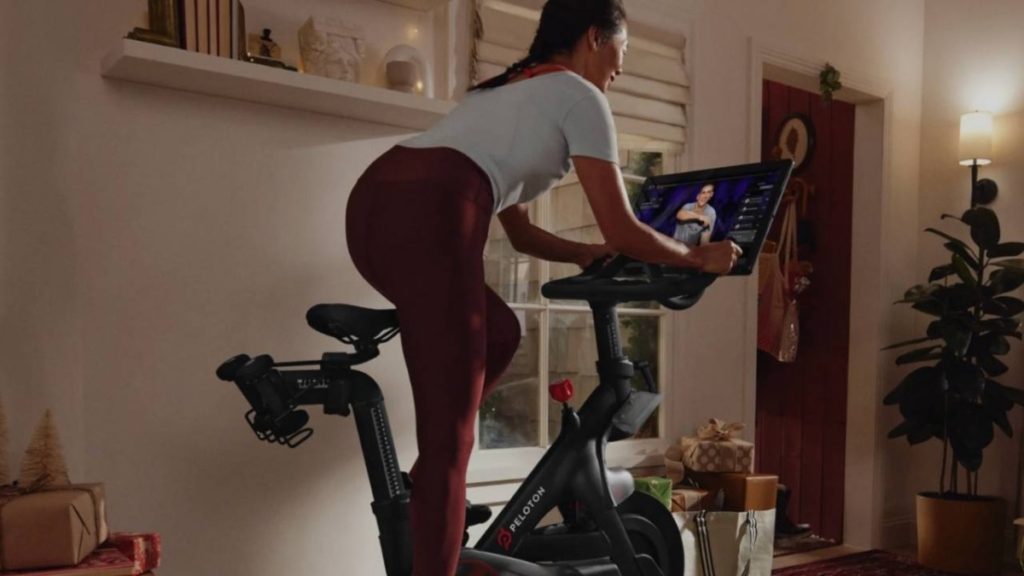
Peloton Shoes Squeak When Standing
Have you ever been in a situation where you Peloton shoes squeak when standing and it’s really annoying? Well, if you have Peloton shoes, this can be a common problem. The shoes are designed to be durable and to provide good traction while pedaling, but they also tend to squeak when you’re not pedaling.
This can be especially problematic if you’re in a class and the instructor is trying to give directions over the music. If your shoes are squeaking, it can be difficult to hear what the instructor is saying. If you’re looking for a way to stop your shoes from squeaking, there are a few things you can try.
First, make sure that the shoes are properly laced. If the laces are too loose, they can rub against the shoes and cause them to squeak.
Second, try tightening the shoes with an Allen wrench. This will help to secure the shoes and prevent them from moving around. Finally, if all else fails, you can always try adding some baby powder to your shoes. This will help to absorb any moisture that might be causing the shoes to squeak.
Why Do My Peloton Shoes & Peloton Pedals Squeak Summary
It’s really easy to fix the problem of your Peloton shoes squeaking and it could be something simple like tightening your shoes or wearing the right socks.
If you’re experiencing any squeaking with your Peloton shoes, it might not be the shoes themselves. Your Peloton pedal squeaking might be the real reason. Without lubrication and grease on your cleats and Peloton pedal mechanisms, they may start to wear down and develop a loose-fitting connection, leading to more noise than normal.
